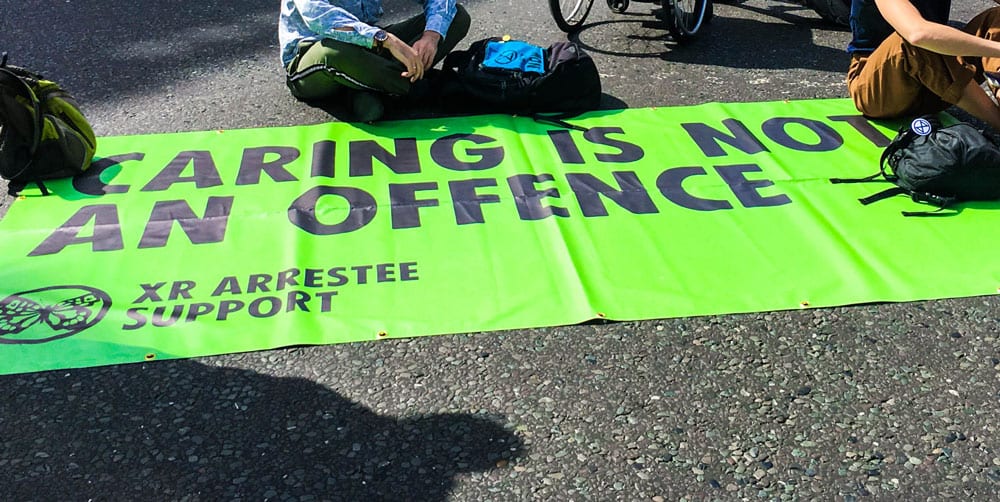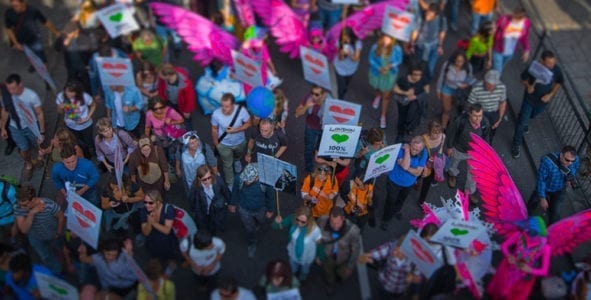Disobedience, Protest, and the Pandemic: Climate Change and Citizen Action under Conditions of Social Distancing
Civil disobedience is not just a checklist of components, but a tradition of morally purposeful action and an expression of citizenship, CUSP Fellow Graeme Hayes writes. As the pandemic ushers in new social norms, and political and economic interests may seek to capitalise on the crisis to further deepen social inequality, how social movements rethink their tactics may have profound consequences for the effectiveness of future protests.

So far, the COVID-19 pandemic has claimed the lives of over 200,000 people; if we measure excess deaths against the five year average, the figure is even higher, at over 300,000. To stem the tide, liberal and authoritarian states worldwide have introduced social restriction regimes with varying intensities, speeds, and success. By the end of March, 2.6 billion people, or a third of the global population, were living under some form of ‘lockdown’. The social and economic consequences are profound, with the IMF predicting the global economy to shrink by 3% in 2020, the ILO emphasising the devastating effects of workplace closures on 1.6 billion workers in the informal economy. Poorer and more marginalised populations are not only more likely to be exposed to the virus; they are less likely to be able to adapt to and cope socially and economically with conditions of lockdown. This is, as Richard Horton writes in The Lancet, a global health crisis whose meanings are not biological but biographical, located in the vast social inequalities and organisational assumptions that underpin late capitalist societies.
For social movements seeking fundamental social transformation, the lockdown has created a series of challenges, as established ways of taking action are destabilised by emergent norms of ‘social distancing’. This is particularly the case for movements whose underlying critique focuses on the crisis of representative democracy, whose goals focus on developing new forms of participatory citizenship, and—like Extinction Rebellion—whose actions emphasise the political potential of civil disobedience. Disobedience during the lockdown has of course been widely reported in the media, with much attention paid to public protests in front of state capitols in the United States, and what they might mean for the limits of public compliance with social restrictions. For some, these protests are powerful expressions of civil disobedience. But looking a little deeper helps us define both why this is not a politically productive way of thinking about civil disobedience, and why civil disobedient action is made much harder by lockdown conditions.
In classic liberal political theory, John Rawls (1971) defines civil disobedience as a ‘public, nonviolent, conscientious yet political act contrary to law’ whose aim is to advance collective justice and democratic cooperation in ways that are nonetheless consistent with the rule of law and the operation of liberal pluralist institutions. Because breaking the law breaks the social contract (it is antithetical to the collective democratic will), civil disobedience can only be justified under specific and exceptional circumstances: where there is ‘substantial and clear injustice’, and where action furthers ‘the path to removing other injustices’. For Rawls, in other words, civil disobedience can only be justified where it improves the quality of representative justice, by extending or protecting fundamental citizenship rights.
Civil disobedience is not just a checklist of components, but a tradition of morally purposeful action, and carries a series of progressive political values.
The US anti-lockdown protests therefore seem to offer a prima facie case of civil disobedience: protests are public, at least so far nonviolent, and conscientious; they are political acts (against ‘state government tyrants’, according to the organisers of the MAGA MayDay ‘Rally for Freedom’), contrary to law (producing at least the threat of prosecution of protest leaders, as in San Diego); and they explicitly address fundamental citizenship rights (in the US, free assembly is a protected First Amendment right). Though civil disobedience is a collective action whose goal is to provide collective social benefits, the individualism of these protests is not unprecedented within US political culture: Thoreau, widely considered the originator of civil disobedience in 1840s Massachusetts, took his own action as part of his philosophy of moral individualism, arguing that no government was the best government of all. Moreover, the US protests are characterised by a strong appeal to collective identity (with national and often Confederate flags prevalent).
Yet in collective action terms, the picture is less straightforward. Civil disobedience is not just a checklist of components, but a tradition of morally purposeful action, and carries a series of progressive political values. Activists engaging in civil disobedience typically distinguish their action by making appeals to this tradition, and to these values; this distinguishes democratic pluralism from, for example, agonistic traditions of class conflict, and from anarchist direct action (Sommier, Hayes and Ollitrault 2019). In the absence of a political imaginary capable of carrying progressive pluralist values, potential claims to civil disobedience are at best weak. Moreover, proceeding from the progressive tradition, civil disobedience is not just a collective civic act in that it involves organised actors; it is a collective civic act in that it expresses profound bonds of social solidarity. In the face of a pandemic with high transmission rates which disproportionately affects older, more vulnerable, and more socially marginalised populations, actions allegedly designed to protect civic freedoms are inevitably only designed to promote the civic freedoms of some at the expense and wellbeing of others. These are not acts fostering social proximity: these are acts of free-riding. ‘Social distancing’, indeed.

Extinction Rebellion and Civil Disobedience
More generally, for movements who do carry these progressive pluralist values and engage in civil disobedience, the pandemic poses a series of challenges to established modes of action. Take Extinction Rebellion (XR). Planned by a small group of activists with previous experience in climate and human rights activism and the Occupy movement, XR’s model of collective action fits within and consciously appeals to longstanding traditions of disruptive social action. Locating the climate crisis in the wider crisis of representative democratic institutions, it has mobilised tens of thousands of people to commit civil disobedience, with the goal of extending collective procedural justice through the creation of new participatory democratic forums. In the performance of action, XR offers participants a material and embodied public agency appealing directly to highly encoded norms of democratic participation, as an urgent expression of citizenship in the face of democratic deficits. As a performance of solidarity, open-ness, and accountability, XR emphasises the legitimacy of this action as a reclamation of public space and a mechanism for the production of change. Further, this action is designed to generate a consequent series of direct and unmediated encounters between activists and state institutions, as mass arrests lead to hundreds of court hearings and criminal trials. XR’s objective is both to disrupt the normal functioning of state institutions (and thus build pressure for a just resolution), and to create an institutional space for activists to ‘speak truth to power’.
The experience of the pandemic suggests both positive and negative consequences for this sort of action. Most positively, it suggests that social consent is available for structural change in collective public behaviours, even where suddenly imposed, where publics understand the collective social interest argument underpinning these structural changes. Furthermore, this broad social consent has been underpinned by the multiplication of local mutual aid groups, volunteer networks, social solidarity initiatives, and support for the public sphere. Here, ‘social distancing’ is not self-serving individualism, but the understanding of physical distancing as an act of collective social solidarity. Indeed, the rapid emergence of socially cohesive behaviours on the basis of suddenly shared identities, identified by social psychologists as the formation of ‘collective resilience’ (Drury et al 2019), is characteristic of public responses to crises and disasters. Together, this may therefore suggest that the type of social citizenship that civil disobedience both draws on and aims to foster is a potent resource available to social movements in their attempts to rebuild a more socially just society following the pandemic.
Much less positively, however, and despite the pandemic offering both a vision of ‘how different our cities could be in a carbon-neutral world’ and studies showing life-saving improvements in urban air quality, the extent of carbon emissions reductions made possible through the sort of structural change experienced under the pandemic is relatively slight. Carbon Brief estimates the pandemic will lead this year to the largest absolute annual decline in global emissions ever recorded; but this figure will still be short of the reductions required every year to meet the 1.5oC global temperature limit. Even with five pandemics in the next decade, emissions reductions would only reach 2oC. Of course, these emissions reductions are neither socially just, nor the result of democratic deliberation, whilst even the maintenance of reductions produced by a short-term economic contraction depends on the maintenance of states of emergency, without which emissions are likely to rebound sharply, particularly under the influence of growth maximisation strategies promoted by entrenched economic interests.
In other words, even where imposed suddenly and massively and with wide public consent, social behavioural change has limited potential for carbon reduction without a collective transformation of the techno-economic structures that underpin social organisation. Meanwhile, effective climate action requires not just the maintenance of pandemic response reductions, but their acceleration under conditions of democratic participation. However, as Drury et al underline, where the new shared identities that emerge during crises are not explicitly sustained and mobilised post-crisis, they typically decline as the sense of a common fate (and thus of a shared identity) breaks down, resources are removed, and energy dissipates.
Disobedience after the Pandemic
What does this mean for civil disobedience? The case for transformative collective action has been amplified by the pandemic, whilst at least some of the social conditions appear in place for it to spread. But a comparison with the global financial crash is instructive. A decade ago, liberal democratic governments sought to recoup the vast public expenditures they had laid out to support the financial system by defunding social welfare and the public sector. This, in turn, set the conditions for mass mobilisations marrying traditional demands for redistributive economic justice with novel demands for procedural justice (Hayes 2017). In his analysis of public action in southern Europe, Gerbaudo (2017) identifies this moment as the emergence of new discourses and practices of ‘citizenism’, which he defines as ‘the project of a popular reclaiming of citizenship’ based on the occupation of public space and demands for the development of new forms democratic participation. Like civil disobedience more generally, this form of action retains a view of the state as the basis of social cohesion, as the means of the enactment of collective transformation (and is to this extent opposed to the anarchist and autonomous operational principles of direct action more common to Occupy).
Post-pandemic, we may see the emergence of new forms of citizenism. Equally, it is entirely possible that as ten years ago, political and economic elites will seek to recoup the vast financial expenditures laid out for the temporary protection of businesses and furloughed workers in the same way as before: through social disciplinary processes of debt transfer conducted against the most socially and economically vulnerable sections of the population in disproportionate and specifically-targeted ways. This process will inevitably engender organised social conflict in specific material spaces (indeed, as current calls to rent strikes in the US show, the discriminatory nature of government support is already engendering these conflicts). Yet new public norms of behaviour also run counter to the staging of disobedient protest, as it does for the repertoires of mass collective public protest generally. The pandemic threatens the material imaginary of embodied action: expressions of solidarity and collective power through physical proximity and interaction are particularly destabilised by new norms of social distancing, as protest behaviours designed to project feelings of citizenship may now suggest the opposite of citizenship.
The risk is that, particularly in a highly decentralised movement, the tension between these two imperatives—performing citizenship, and acting in an emergency—pull in very different directions. In the UK, XR is currently drawing on its organisational model, holding regional online ‘People’s Assemblies’ in order to decide when and how future action might be staged. Meanwhile, in what is perhaps a sign of things to come, a group called ‘HS2 Rebellion’ blocked the site entrance at Euston on 4th of May, standing 2 metres apart, jogging on the spot, arguing with police that their blockade amounted to ‘essential exercise’, demanding construction work stop and the money for HS2 be diverted to the NHS instead.
Immediately, a pro-HS2 group claiming to be affiliated to XR (but which has nothing to do with XR and is likely to be a false flag group) denounced the action, claiming it was ‘putting people at risk in terms of breaching social distancing’. The argument fundamentally concerns political vision, but the mode of address proceeds by locating social legitimacy in the detail of the performance of action.
Meanwhile, the potential shifting of disobedient action into online spaces can be expected to cause problems associated with a lack of social visibility, as the openness and accountability central to the practice of protest as citizenship are also less clearly present. Further, the claiming of public space is not just a means to an end, but an objective in itself, in the face of democratic enclosure and the privatisation of such space; moving action online risks eroding embodied practice, and also reconfiguring action as both less obviously disruptive and less politically potent. Movements, of course, are creative, whilst established repertoires of action are enduring; and both mobilising creativity and a potential ‘return to normal’ are possible outcomes for social movement tactics after the pandemic. In the face of political and economic interests seeking to capitalise on the public health crisis to further deepen social inequality, it is likely that how social movements assert their collective agency will at least in part determine whether even the modest and uneven collective gains made under the conditions of pandemic can be maintained.
References
Drury J et al. 2019. Facilitating Collective Psychosocial Resilience in the Public in Emergencies: Twelve Recommendations Based on the Social Identity Approach. Frontiers in Public Health, 4 June 2019, https://doi.org/10.3389/fpubh.2019.00141
Gerbaudo, P. 2017. The Indignant Citizen: Anti-Austerity Movements in Southern Europe and the Anti-Oligarchic Reclaiming of Citizenship. Social Movement Studies, 16/1, pp.36-50.
Hayes G. 2017. Regimes of Austerity. Social Movement Studies, 16/1, pp.19-35.
Rawls J. 1971. A Theory of Justice. Harvard: Harvard UP.
Sommier I, Hayes G, and Ollitrault, S. 2019. Breaking Laws. Violence and Civil Disobedience in Protest. Amsterdam: Amsterdam UP.






